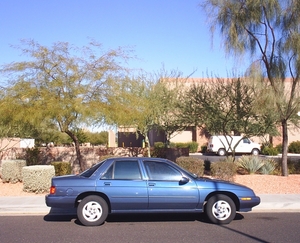Without transportation, the world economy would grind to a screeching halt. Almost every adult relies on their car or truck to get them to work, the grocery store or wherever it is that they need to go. It’s no wonder that there are so many used car dealerships, especially considering the potential for profit when dealing with such high priced products.
Automobiles are complicated pieces of machinery, and there is a lot of potential for hidden problems that may only arise after you’ve bought the vehicle. This article contains information that I learned as an employee of a small used car dealership. It contains information that will help you avoid buying a car that has major mechanical problems. I will also provide tips on buying a car including negotiating and info to help you spot an unlicensed car dealer, or curbstoner, as they are sometimes called.
Buying A Used Car:
It’s is so very important to inspect any used car thoroughly- even if you’re shopping at established car dealerships, but even more so if you’re buying from an individual. The first step in buying a used car is to find one. I recommend looking in Craigslist or your local newspaper. You can either look at one car at a time, or several in a day. Once you’ve got your list, it’s time to call the owner of the car.
Phone Interview:
There are a few important questions you should ask to get a feel for the car. Feel free to omit any questions that are answered in the advertisement. You should ask about any noises the car makes, ask if it smokes. Ask if it shakes or does anything unusual. Ask how many miles are on the odometer, and what type of transmission the car has if that is something that is important to you. Ask about body damage.
Ask if the registration is current- if the registration is not current, or it expires very soon, you should beware. Odds are that the car failed a state smog inspection. This could be very costly, and is indicative of mechanical problems. Also, it’s generally a headache and creates an unnecessarily stressful situation.
If the car sounds like something you’d like to buy based on the phone interview, ask the seller if their price is flexible. You can even make an offer at this point, but don’t offer too little, or the answer you may get will simply be a flat out no. A few hundred dollars less than the asking price is a good starting point.
Car Inspection:
First, walk around the car, looking for blemishes and body damage. If there is damage on doors, trunk or hood, check to make sure that they open and close properly. Check the interior for rips, tears or anything broken. Check the tires for uneven wear, and to determine if new tires will be needed. If there’s uneven wear, it could mean a few things. If the wear is only on one side of the tire, the car could need alignment or some other kind of repair. If tire wear is only in the middle of the tire or it is on both sides of the tire, this is due to over or under inflation. Next, we will pop the hood.
Ideally, the engine will be cold when you arrive. You can even ask the owner not to start the car before you arrive. There are a few reasons for this- first, the car could be hard to start when it is cold. It’s always good to know that the car you’re buying will start right up. A hard starting car could need injectors, gaskets, fuel filter, fuel pump or any number of things. The car could also have a dead battery and need a jump start. It could even have a bad starter.
The most important reason to see the car when the engine is cold is that you should not remove the radiator cap when an engine is warm- the coolant is under pressure, and it will spew out like a volcano. Inspecting the coolant is very important. The coolant should be clear and florescent. Most coolant is green, and looks like lime kool-aid. Some coolants are red or orange, but the coolant should still be a clear florescent color. If it is murky, the car has likely not been well maintained. This leads us to the most important aspect of inspecting a used car:
Checking for hidden engine problems:
A blown head gasket is a very expensive repair. Sure, the part only costs twenty dollars or so, but the labor includes disassembling the top end of the motor and it is a labor intensive job that can cost you three hundred dollars, six hundred dollars or more depending on the vehicle in question. I cannot stress enough the importance of checking a motor for head gasket problems. Blown head gaskets are often caused by overheating, so avoid cars that overheat or have overheated in the past. Overheating can also warp the head of a motor.
First, we check for water in the oil. Open the oil cap. Look at the cap. If the oil cap is milky or you see a substance that resembles a chocolate milkshake, there are head gasket issues. I recommend walking away then and there. Do not pass go, do not collect two hundred dollars. While you are doing this step, look inside the engine if possible. A well maintained engine will look fairly clean inside. If there’s a lot of black oil buildup on the internal engine parts, it could have been overheated, poorly maintained or poor quality oil has been used.
While you’re at it, check the oil. Remove the dipstick, wipe it off with a clean cloth, re-insert the dipstick and check the oil level. If it is low or very dark, this is likely an engine that consumes oil. Now wipe the oil on the cloth again and look at he oil on the cloth. If there are metal flakes or black spots left behind, the engine is probably not very healthy. Metal flakes are especially bad- not only is the engine tearing itself apart, but these flakes floating around in the engine are helping to speed up the process.
Now you should be checking for exhaust leaking into the cooling system. Open the radiator cap and start the motor. Rev the motor. If bubbles come out of the radiator opening, you’ve got head gasket problems. Don’t stand over the radiator cap- it can spew water like a volcano if there is a major head gasket leak.
The final test is to rev the motor and look at the exhaust. Have someone rev the engine while you look at the tailpipe. If the exhaust is blue-gray, the engine burns oil, and you should avoid buying this car. It likely needs expensive internal repairs. If there is black smoke, this indicates an overfueling problem- meaning that there is a problem with injectors or the carburetor. Water spewing from the tailpipe also means that there’s a head gasket problem. A little of white water steam and water condensation dripping from the exhaust is normal. Regardless, the exhaust shouldn’t be very visible, and it shouldn’t smell very strongly. A rotten egg smell means that the catalytic converter need replacement.
If the car has an automatic transmission, check the level, color, and smell of the fluid. It should be pink or tan, not brown. It should not smell burnt. The transmissions is the easiest part of a car to break and the most expensive to fix. Abusive driving can ruin an automatic transmission in half on hour. Avoid transmission problems at all costs!
Many used car dealers will have the top of the engine steam cleaned before they try to sell the car. A clean upper engine doesn’t necessarily mean a leak free engine. You may want to check the bottom of the engine for leaks. It should be fairly dry and clean. Also look at the ground where the car is usually parked. Leaks can be expensive to repair, or they can be fairly inexpensive, but you probably won’t know until you take the car to a mechanic.
This may seem like a lot of work to do, but it can all be done in just a few minutes, and will keep you from buying a car that has expensive mechanical problems. When in doubt, take the car to a mechanic. If the owner of the car has any objections, I would avoid buying this car.
The Test Drive:
Once you’ve inspected the car and determined that the engine is sound and you still think that this is a car that you’d like to purchase, it is time for a test drive. If you don’t like the car by the time you’ve reached this step, you should move on to the next car. Don’t waste your time or the owners time.
When you first start the engine, all of the warning lights should come on as a test of their functionality. If the check engine light does not come on, it has likely been disconnected. You should avoid a car that does this. Also, the oil light should turn off in one or two seconds. If not, there could be oil pressure problems.
For cars with automatic transmissions- before you drive, apply the brakes, put the car in drive. You should feel the transmission engage almost instantly. You should feel the car trying to creep forward. The transmission should engage smoothly without jerking or making noise. Now, without letting off of the brakes, put the transmission in reverse. Again, it should engage almost immediately without any noise or jerking. You should now feel the car trying to creep backwards.
If the transmission takes more than one second to engage, or engages harshly with jerking or clunking, this indicates a worn transmission or a transmission with problems. Once again, if this happens, it’s time to walk away.
While test driving the car, try to sense any unusual behavior. Do not drive with the radio on. You can check it to see if it works, but then turn it off while you’re driving. You should try to test drive the car for as long as possible to reveal any hidden quirks. At the very least, drive the car for five or ten minutes after it has reached normal operating temperature. Listen for any unusual sounds- grinding sounds, clicks, etc. Check to make sure that the odometer is working. The temperature gauge should stay steady after it has reached normal operating temperature. The engine should not make a lot of noise, and the transmission should shift smoothly without hesitation between all gears. On cars equipped with standard transmissions, avoid cars that make crunching sounds when shifting gears or are hard to shift.
You should take the car on a freeway if at all possible. You want to make sure that the car engages into overdrive and doesn’t shake or pull to one side. Also, try to drive the car somewhere where you can turn sharply both left and right. If the car makes a clicking or clunking sound when doing this, it likely needs new CV axles. This is a four hundred dollar repair including parts and labor.
The brakes should operate smoothly without any grinding, squeaking or pulsing. Any of these symptoms indicate brake wear. Sometimes a little squeaking is alright, but it generally indicates worn brake pads. Grinding and pulsing means that the rotors need resurfacing or replacement. If you know how to do this yourself, this can be an inexpensive repair, and can give you some serious negotiating leverage, as most shops will charge one hundred dollars or more for brake work.
Final negotiation:
If, after a thorough inspection and test drive, you are interested in buying the car, you’ll want to see the title of the car. Check for liens and salvage titles. Many insurance companies won’t insure a car with a salvage title, so it’s best to avoid these cars. Also, salvage titles mean that the car has had major repairs done, and it was likely in a wreck.
Even if you’ve already negotiated a bit on the phone, you can usually get the seller to budge a little on their price. If you haven’t negotiated over the phone, you should offer a hundred less than you actually want to pay- usually two or three hundred less than the asking price. The seller will usually try to negotiate up. If the seller doesn’t seem to be interested in your final offer, show them that you have cash on hand. As the old saying goes- money talks.
To be absolutely safe, have the title transfered into your name at the motor vehicle department with the owner of the car present. Do not hand the money over until the title is in your name and you’ve verified that there are no liens on the car.
Avoiding used car dealers:
Some people don’t like buying cars from those who buy and sell cars for a living. This is understandable, as some unlicensed car dealers are less than honest. Others are simply mechanics that know how to spot a good deal and can repair cars at low cost.
There a few indicators that the person you are dealing with is a car dealer.
First, check for multiple car listings with their phone number. This is not so easy if you’re browsing the classifieds in your local newspaper, but if you’re using Craigslist, you can search for their phone number (use quotes, or just enter the last four digits of their phone number). You can also try searching Craigslist for the number that is in the newspaper. If they have more than one car listed for sale, it is likely that they are a used car dealer.
How to spot a used car dealer:
The seller has multiple cars for sale
The car appears to have been recently detailed
The seller doesn’t have a license plate for the car
The seller has a notarized title or a title with seller information already filled out
The name on the title isn’t the name of the seller
The address on the title is nowhere near where the car is being sold
The seller won’t meet you at their home
Of course, none of these are surefire indications that you’re buying from a used car dealer- in the end, you just have to go with your gut feeling. Sometimes, it’s obvious. One time I went to look at a car, and the guy had three different license plates in the trunk of his car. That’s a good indication if I ever saw one.
Summary:
If you’re going to take anything away from this article, this is it:
Check for blown head gaskets.
Negotiate on price over the phone and after the test drive.
Money talks- present cash to unmotivated sellers.
Avoid cars with transmission problems and blown head gaskets.
When in doubt, take the car to a mechanic for inspection.
Complete the transaction at the department of motor vehicles.
Do not hand over the money until you have the title in your name and in your hand.
You should now have all of the information necessary to successfully and safely buy a used car without major mechanical problems while avoiding being scammed.






